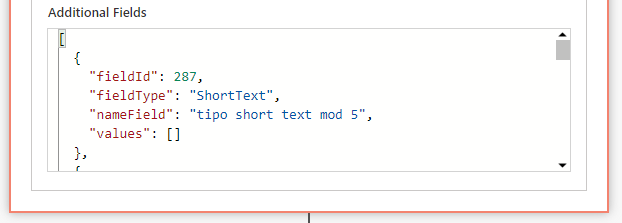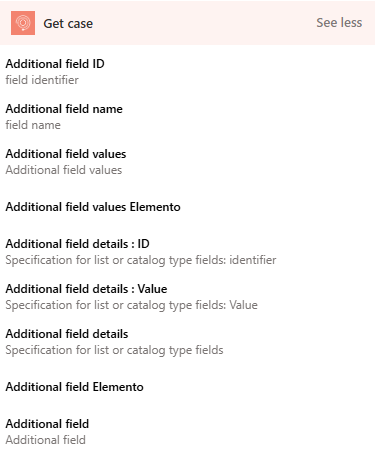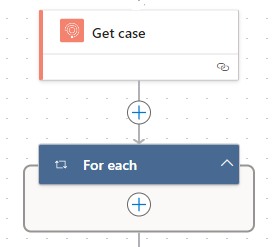To get the case details using the connector Aranda Service Management Consider the following steps:
1. Get the Id By Project (enter the ASMS environment to get the case ID).

2. Select the function Get case

3. Enter the required value:
- Id By Project
You will get the following answers:

| Name | Identifier | Guy | Description |
|---|---|---|---|
| Additional Fields | additionalFields | Array | Additional case fields, depending on the retrieved case |
| Attachments | attachments | Array | Attachments to the case |
| Applicant ID | applicantId | Integer | Applicant Identifier |
| Author ID | authorId | Integer | Author identifier |
| Author | authorName | String | Author name |
| Id by project | idByProject | String | Case Project Identifier |
| Case ID | Id | Integer | Case Identifier |
| Case Type ID | itemTypeId | Integer | Case Type Identifier |
| Case Type | itemTypeName | String | Case Type Name |
| Category ID | categoryId | Integer | Category identifier |
| Category | categoryName | String | Category Name |
| CI ID | CiId | Integer | Configuration item identifier |
| CI | ciName | String | Configuration item name |
| Client ID | customerId | Integer | Customer ID |
| Client | customerName | String | Client Name |
| Closed Date | closedDate | String | Closing date |
| Closed | isClosed | Boolean | Closing |
| Company ID | companyId | Integer | Company Identifier |
| Company | companyName | String | Company Name |
| Costs | Cost | number | Costs |
| Description | Description | String | Case description |
| Estimated Cost | estimatedCost | number | Estimated costs |
| Estimated Date | estimatedDate | String | Estimated Date |
| Final date | finalDate | String | End date (available for Task cases) |
| Group ID | groupId | Integer | Responsible Group Identifier |
| Group | groupName | String | Name of the responsible group |
| Impact ID | impactId | Integer | Impact Identifier |
| Impact | impactName | String | Impact Name |
| Interface ID | interfaceId | String | Interface ID |
| Model ID | modelId | Integer | Model identifier |
| Model | modelName | String | Model Name |
| WAVE ID | HelloId | Integer | OLA Identifier |
| WAVE | olaName | String | Name OLA |
| Organizational Area ID | unitId | Integer | Organizational Area Identifier |
| Organizational Area | unitName | String | Name of the organizational area |
| Price | Price | number | Price |
| Priority ID | priorityId | Integer | Priority identifier |
| Priority | priorityName | String | Priority Name |
| Progress | currentProgress | Integer | Progress |
| Project ID | projectId | Integer | Project Identifier |
| Project | projectName | String | Project Name |
| Provider ID | providerId | Integer | Provider Identifier |
| Provider | providerName | String | Provider Name |
| Real Cost | realCost | number | Actual Cost |
| Real Date | realDate | String | Actual Date |
| Reason ID | reasonId | Integer | Change reason identifier |
| Reason | reasonName | String | Change Reason Name |
| Registry Date | openedDate | String | Registration Date |
| Registry Type ID | registryTypeId | Integer | Record Type Identifier |
| Registry Type | registryTypeName | String | Name of the record type |
| Responsible ID | responsibleId | Integer | Identifier of the controller |
| Responsible | responsibleName | String | Name of the person in charge |
| Risk ID | riskId | Integer | Risk identifier |
| Risk | riskName | String | Risk Name |
| Service ID | serviceId | Integer | Service Identifier |
| Service | serviceName | String | Service Name |
| SLA ID | SlaId | Integer | SLA Identifier |
| SLA | SlaName | String | SLA Name |
| Solution | commentary | String | Case Solution |
| Status ID | stateId | Integer | State ID |
| Status | stateName | String | State Name |
| Subject | subject | String | Subject of the case |
| UC ID | UCID | Integer | UC Identifier |
| UC | ucName | String | UC Name |
| Urgency ID | urgencyId | Integer | Urgency identifier |
| Urgency | urgencyName | String | Name of the emergency |
Additional Fields
For the additional fields, a JSON is presented with the following structure:

{
"additionalFields": [
{
"fieldId": 0,
"fieldType": "",
"nameField": "",
"values": [
""
],
"valueDetails":{
"id": 0,
"value": ""
}
}
]
}
Where:
-fieldId: Id of the additional field.
-fieldType: Additional field type.
-nameField: Name of the additional field.
-Values: Additional field value, the values it returns are similar to those entered when a record is created or updated, this value depends on the type of field, for more information see: Additional fields
-valueDetails: Corresponds to the detail of the list or catalog type fields:
- Id: Corresponds to the system ID for the catalog value.
- value: Corresponds to the name or label of the catalog value.
To operate the connector you can make use of the properties shown below:

Using the integrated action:


Attachments
For attachments, a JSON is presented with the following structure:

{
"attachments": [
{
"id": 0,
"name": "",
}
]
}
Where:
-Id: Corresponds to the system ID for the attachment.
-name: Corresponds to the name of the attachment.
To operate the connector you can make use of the properties shown below:

Using the integrated action:




